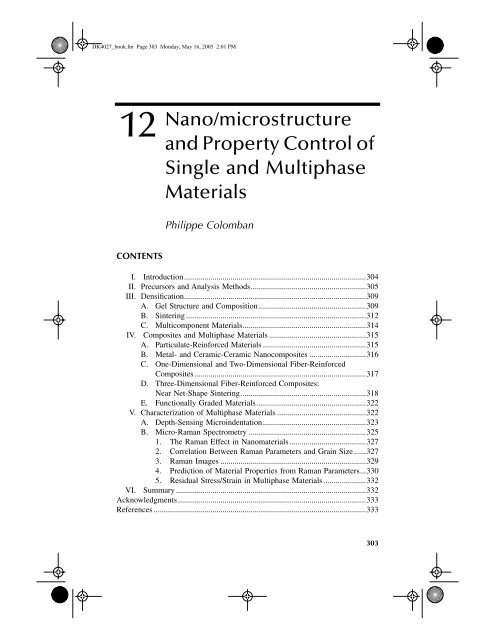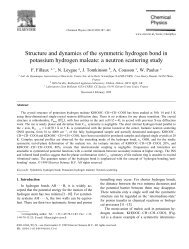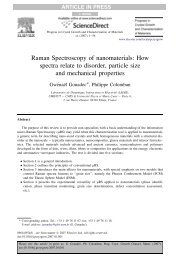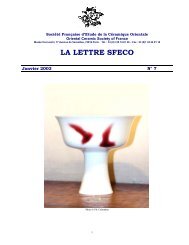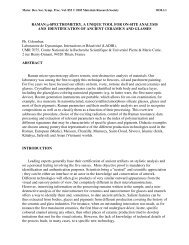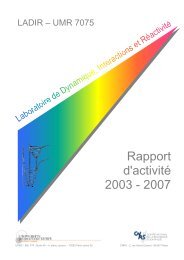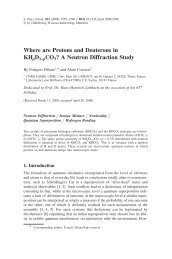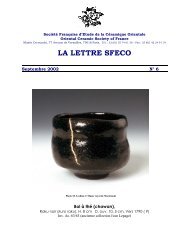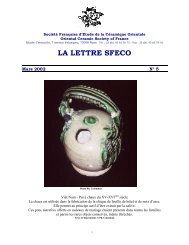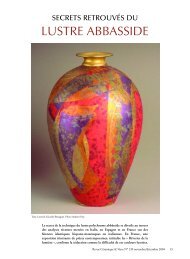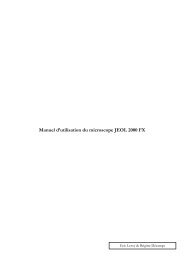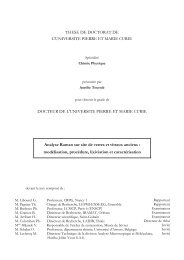12 Nano/microstructure - institut de chimie et des materiaux paris-est
12 Nano/microstructure - institut de chimie et des materiaux paris-est
12 Nano/microstructure - institut de chimie et des materiaux paris-est
- No tags were found...
Create successful ePaper yourself
Turn your PDF publications into a flip-book with our unique Google optimized e-Paper software.
DK4027_book.fm Page 305 Monday, May 16, 2005 2:01 PM<strong>Nano</strong>/<strong>microstructure</strong> and Multiphase Materials 305Polymerized alkoxi<strong>de</strong>sChemical gel from gel-formersColloidal solPhysical gelMIXINGliquidSilanesSilazanes,...Salt pow<strong>de</strong>rs or solubles salts(a)Al 2 O 34ZrO 2·6SiO 2ZrO 2·4SiO 24ZrO 2·3P 2 O 5ZrO 2·P 2 O 5Na 2 OSiO 2SiO 2Na 2 ONa 2 O·CaO·2Al 2 O 3Na 2 OZrO 2P 2 O 5 SiO 2P 2 O 5(b)ZrO 2·Na 2 OFIGURE <strong>12</strong>.1 (a) Schematic flowchart of hybrid routes. (b) Sol-gel forming compositions(alkoxi<strong>de</strong> route) in the SiO 2 -Al 2 O 3 -ZrO 2 -P 2 O 5 , 4ZrO 2·6SiO 2 -Na 2 O-4ZrO 2·3P 2 O 5 , ZrO 2 -Na 2 O-SiO 2 , ZrO 2 -P 2 O 5 , ZrO 2·Na 2 O-SiO 2 , ZrO 2·4SiO 2 -Na 2 O-P 2 O 5 , and SiO 2 -P 2 O 5 -Na 2 O·CaO·2Al 2 O 3 phase diagrams. The representation corresponds to the final oxi<strong>de</strong>composition. Solid line indicates the limit of optically clear gel by slow hydrolysis.Dashed line indicates the limit of easy synthesis of (translucent) monolithic gels.(Reprinted from Colomban, P., Gel technology in ceramics, glass-ceramics and ceramicceramiccomposites, Ceram. Int., 15, 23, 1989. With permission from Elsevier.)II. PRECURSORS AND ANALYSIS METHODSPrecursors must have different properties: 4–14 (1) a high content of the finalelements (mostly aluminum, silicon, zirconium, titanium, phosphorus), (2) a lowcontent of health hazardous elements and elements that corro<strong>de</strong> the equipment(e.g., chlorine, sulfur), (3) a viscosity adapted to the process: low viscosity forpreform infiltration, medium viscosity for spinning and coating, (4) a controlledprecursor-ceramic transformation (bubbling is researched for foams but not for<strong>de</strong>nse parts), (5) the ability to be mixed with other precursors or to be processed(“good” hydrolysis rate), and (6) low cost.Regarding sol-gel routes, the most used reagents are those ma<strong>de</strong> with gelformercompositions: aluminium-s-butoxi<strong>de</strong> [Al(OC 4 H 9 ) 3 ], t<strong>et</strong>ra<strong>et</strong>hoxysilane[Si(OC 2 H 5 ) 4 ] (and homologous m<strong>et</strong>hoxysilane), aluminum-silicon <strong>est</strong>er
DK4027_book.fm Page 306 Monday, May 16, 2005 2:01 PM306 Chemical Processing of Ceramics, Second Edition[(OC 4 H 9 ) 2 -Al-O-Si(OC 2 H 5 ) 3 ], zirconium-i-propoxi<strong>de</strong> [Zr(OC 3 H 7 ) 4 ], titaniumbutoxi<strong>de</strong> [Ti(OC 4 H 9 ) 4 ] and propoxi<strong>de</strong> [Ti(OC 3 H 7 ) 4 ], tributylborate [B-(OC 4 H 9 ) 3 ],and tributylphosphate [P-(OC 4 H 5 ) 3 ]. 6–17 Figure <strong>12</strong>.1b shows the basic SiO 2 -Al 2 O 3 -ZrO 2 -P 2 O 5 quaternary diagram and some related ternary diagrams. The dottedregions correspond to composition ranges easily giving optically clear (high dot<strong>de</strong>nsity) or translucent (low dot <strong>de</strong>nsity) gels. The dashed line corresponds to thelimit of easy synthesis. The handling of aluminum and some other reagents likegermanium propoxi<strong>de</strong> [Ge(OC 3 H 7 ) 4 ] requires a glove box free of H 2 O traces.Homema<strong>de</strong> preparations of very hygroscopic alkoxi<strong>de</strong>s guarantees their quality.However, in the preparation of multicomponent materials through the sol-gelroute or by mixing organic precursors, <strong>de</strong>termination of the m<strong>et</strong>al element contentis not obvious. 7 In commercially available reagents, the m<strong>et</strong>al content often variesfrom batch to batch and a slight prehydrolysis is often observed. The <strong>de</strong>gree ofhydrolysis can be <strong>de</strong>termined by nuclear magn<strong>et</strong>ic resonance (NMR), infrared(IR) absorption, or Raman scattering. 14,16–18 This modifies the m<strong>et</strong>al content andthe viscosity. The viscosity of the alkoxi<strong>de</strong>s can be adjusted at values of approximately1 poise by heating below 80°C for most of the reagents. Mixing of liquidprecursors promotes the intimate combination of various precursors at the molecularscale and allows adjustment of the viscosity to void filling requirements.One of the main inter<strong>est</strong>s of liquid alkoxi<strong>de</strong>s is that they exhibit a rather goodceramic yield: typically the alkoxi<strong>de</strong>-to-ceramic conversion yield is b<strong>et</strong>ween 20 and30 wt%. Thermal treatments un<strong>de</strong>r various atmospheres (NH 3 , H 2 S, CO) lead to(oxy)-nitri<strong>de</strong>s, -sulfi<strong>de</strong>s, -carbi<strong>de</strong>s, and <strong>de</strong>rivatives. 1,19 However, carbi<strong>de</strong>s, nitri<strong>de</strong>s,and their oxy<strong>de</strong>rivatives are generally prepared by cross-linking and ceramizationof specific precursors: polycarbosilanes, polysilazanes. Since the work of Yajima <strong>et</strong>al., 20,21 polycarbosilane (PCS) is well known as a precursor of SiC materials. 22,23 Thehigh viscosity of this precursor is convenient for fiber spinning, but prevents its us<strong>et</strong>o fill a fiber preform already filled with a submicrom<strong>et</strong>er pow<strong>de</strong>r. Unfortunately theoxygen-driven r<strong>et</strong>iculation of the chains of the precursor, convenient for films andfiber, is not obvious insi<strong>de</strong> a thick sample, which makes it difficult to control th<strong>est</strong>oichiom<strong>et</strong>ry in the whole. Polyvinylsilane (PVS) fulfills the specific requirementsfor the infiltration of a porous body: 22 (1) a thermostat behavior with a cross-linkingtemperature (200°C to 300°C) far enough from the beginning of pyrolysis (400°C)to avoid formation of bubbles during the cycle; (2) a relatively low molecular weight(MW < 1000), which ensures a sufficiently low viscosity (e.g., 0.3 poise at 130°C)to allow injection in the fiber preform at “low” temperatures; (3) a very high ceramicyield: 64% in weight; and (4) a silicon/carbon stoichiom<strong>et</strong>ry leading to air-stablematerials. A vari<strong>et</strong>y of precursors of carbi<strong>de</strong>, nitri<strong>de</strong>s, and their mixture are nowavailable for many applications. Last-generation precursors use γ radiation to <strong>de</strong>velopan intrinsic cross-linking b<strong>et</strong>ween precursor chains instead of the extrinsic Si-O-Sibridging obtained by controlled oxidation.Generally, the main qu<strong>est</strong>ions that need an answer are:Is the expected composition and structure achieved? Most of the materialsprepared through liquid precursor routes are first obtained in an
DK4027_book.fm Page 307 Monday, May 16, 2005 2:01 PM<strong>Nano</strong>/<strong>microstructure</strong> and Multiphase Materials 307amorphous or m<strong>et</strong>astable form. These forms are very similar to thoseobtained by quenching from a high-temperature melt, but usually r<strong>et</strong>ainhydrogen (protons, OH groups, and –CH branches). 24–26 In the liquidstate the local structure is <strong>de</strong>termined by geom<strong>et</strong>ry constraints. On thecontrary, in the solid state the structure of materials equilibrated at agiven temperature is dominated by long-range Coulombic interactions.Knowledge of the phase relationship diagram is mandatory and thermalexpansion measurement (Figure <strong>12</strong>.2a) is the simpl<strong>est</strong> way to <strong>de</strong>termineit. 4,25–28 Differential thermal analysis (DTA) and phase characterizationm<strong>et</strong>hods (x-ray diffraction [XRD], Raman scattering, IRabsorption) are useful m<strong>et</strong>hods to confirm the phase relationship.Is the sample free of hydrogen? Sol-gel-prepared ceramics easily r<strong>et</strong>ain afew wt% of protons up to 1000°C or more, and these protons drive thesintering and crystallization mechanisms. 24,26 Rather similar amounts ofhydrogen are r<strong>et</strong>ained in carbi<strong>de</strong>s/nitri<strong>de</strong>s <strong>de</strong>rived from polymeric precursors(e.g., in SiC fibers thermally treated at approximately <strong>12</strong>00°C).This hydrogen can generate unwanted gas <strong>de</strong>parture.Is the <strong>de</strong>nsity/porosity convenient for the final use? What is the optimumprocessing temperature? Is the material homogeneous? What are thedifferences b<strong>et</strong>ween the skin and the bulk? Where are the second phaseslocated?Another qu<strong>est</strong>ion is how to select the m<strong>et</strong>hod with the lower cost. The useof hybrid m<strong>et</strong>hods in which part of the elements is introduced from m<strong>et</strong>al-organicprecursors offers the b<strong>est</strong> compromise (Figure <strong>12</strong>.1a).Shrinkage (%)505101520XerogelH 2 OOH −GelPow<strong>de</strong>rNucleationMicrohardness/a.u.10 410 310 2GelMulliteNasiconGlassCeramic200 600 1000 1400 0 500 1000 1500Temperature (°C)(a)Thermal treatmenttemperature/°C(b)FIGURE <strong>12</strong>.2 (a) Com<strong>paris</strong>on of the linear shrinkage of mullite (3Al 2 O 3·2SiO 2 ) micronicpow<strong>de</strong>r, 600°C thermally treated gel (xerogel) and pristine gel. (After Reference 87.) (b)Plot of the R.T. microhardness for mullite and Nasicon (Na 3 Zr 2 Si 3 PO <strong>12</strong> ) as a function ofthermal treatment. (After Reference 27.)
DK4027_book.fm Page 310 Monday, May 16, 2005 2:01 PM310 Chemical Processing of Ceramics, Second EditionFIGURE <strong>12</strong>.4 Scanning electron micrography of optically/translucent NASICON gels (a-c)prepared by different gels routes. An example of fine grained optically clear ceramic (1400°Cfired mullite) is shown in (d) (a-d, reprinted from Ceramic Pow<strong>de</strong>r Science and Technology,Messing, G., Ed., © 1989, with permission from The American Ceramic Soci<strong>et</strong>y; (d) after“Sciences & Techniques”, Céramiques: les progrès <strong>de</strong> la Chimie, © Ph. Colomban).rather globular polymeric entities (diam<strong>et</strong>er 1 nm to 2 nm), which are more orless <strong>de</strong>nsely packed according to the hydrolysis-polycon<strong>de</strong>nsation rate and theinitial alkoxi<strong>de</strong>-solvent-water ratios. An example is given in Figure <strong>12</strong>.4: the sizeof the aggregated moi<strong>et</strong>ies is
DK4027_book.fm Page 311 Monday, May 16, 2005 2:01 PM<strong>Nano</strong>/<strong>microstructure</strong> and Multiphase Materials 311content) and the sintering temperature. The nanostructure and the porosity (andhence the <strong>de</strong>nsification and many other properties) can therefore be tailored bythe chemical param<strong>et</strong>ers controlling the inorganic polymerization and thehydroxyl content: relative proportion of reagents, additions of complexing liquids,temperature, sonification, sintering atmosphere, and heating rate. 7,25,28,30–33 Theseremarks are general: for instance, the chain length of SiC (or C) polymericprecursor <strong>de</strong>termines the silicon/carbon and carbon/hydrogen stoichiom<strong>et</strong>ry,because terminal branches contain more carbon and hydrogen.Like many hydrates, gels present a unique challenge when <strong>de</strong>nsified un<strong>de</strong>rpressure at room temperature. 34–37 Due to the liquid (water generally) present atthe boundary, viscous rearrangement un<strong>de</strong>r pressure allows <strong>de</strong>nsification andoptimization of the contact b<strong>et</strong>ween polymeric grains, approaching the “perfect”packing obtained by sedimentation: true sintering can be achieved un<strong>de</strong>r thecombined action of the pressure and the liquid phase soaked in the pores (watergenerally, but also alcohol). Gel sintering is associated with an increase in opticalclarity. 36 On heating, the grains formed r<strong>et</strong>ain a memory of the packing of primarymoi<strong>et</strong>ies. The grain growth does not <strong>de</strong>stroy this arrangement. Figure <strong>12</strong>.4b showsgel pell<strong>et</strong>s of Nasicon solid solutions prepared by different sol-gel routes. Translucentor even optically clear samples are easily obtained. The plasticity of thegel offers the possibility of facilitating the compaction of any kind of particle,especially those with an elongated shape (whiskers, platel<strong>et</strong>s), by coating eachparticle with a gel film. 37 The gel coating lubricates the particle and promoteshomogeneity of the applied pressure. Plasticity and shapability disappear withthe loss of the water adsorbed at the “grain” surface, above ~200°C. Dependingon the composition, the shrinkage rate then <strong>de</strong>creases up to 500 (zirconia) to1000°C (aluminosilicates), where drastic shrinkage takes place. The latter resultsfrom the backbone rearrangement due to the <strong>de</strong>parture of the last stabilizing OHgroups (Figure <strong>12</strong>.2 and Figure <strong>12</strong>.3). Note that because of the ability of the gelto be <strong>de</strong>formed, a memory effect very similar to the well-known paste memoryof kaolin-rich porcelain paste can be observed. An example is shown inFigure <strong>12</strong>.5, with a compacted pell<strong>et</strong> of zirconia gel fired at <strong>12</strong>00°C.Gels transform more or less gradually into a meso/microporous glass. 24–26 Alogarithmic plot of the weight loss vs. the inverse of the temperature allows theons<strong>et</strong> <strong>de</strong>termination of water and hydroxyl <strong>de</strong>partures, and hence the measurementFIGURE <strong>12</strong>.5 Self-wrapped zirconia pell<strong>et</strong> after firing at <strong>12</strong>00°C (diam<strong>et</strong>er ~10 mm).
DK4027_book.fm Page 3<strong>12</strong> Monday, May 16, 2005 2:01 PM3<strong>12</strong> Chemical Processing of Ceramics, Second EditionTABLE <strong>12</strong>.2Gel Compositions, Specific Area and Hydroxyl Coverage Ratio for SomeHeat-Treated GelsPrecursorThermalTreatment(°C)FormulaSpecificSurface Area(m 2 /g) OH(nm 2 )Aluminum butoxi<strong>de</strong> 300 Al 2 O 2.5 (OH) 0.9 0.4 H 2 O 530 8.8600 Al 2 O 2.8 (OH) 0.35 0.3 H 2 O 350 5.5Aluminum butoxi<strong>de</strong> 400 Si 2 Al 2 O 6.5 (OH) 1.2 H 2 O 680 3.5+ siliconm<strong>et</strong>hoxi<strong>de</strong> (1/1molar)600 Si 2 Al 2 O 6.7 (OH) 0.6 1.9 H 2 O 630 2.2(1/2 molar) 400 Si 2 Al 2 O 6.7 (OH) 0.65 0.9 H 2 O 515 3.1After Vendange, V., and Colomban, P., D<strong>et</strong>ermination of the hydroxyl group content in gels andporous “glasses” issued of alkoxi<strong>de</strong> hydrolysis by combined TGA and BET analysis, J. Porous Mater.,3, 193, 1996.of x and m values in the gel formula. 26,31 Measurement of the specific surfacearea by BET m<strong>et</strong>hods allows the calculation of the hydroxyl coverage ratio.Representative measured gel compositions are given in Table <strong>12</strong>.2. The high valueof the hydroxyl coverage ratio explains the high correlation b<strong>et</strong>ween the hydroxylgroup elimination and the nucleation-<strong>de</strong>nsification reaction.Note that the high specific surface area of gels is not related to their apparent<strong>de</strong>nsity, but to the intrinsic characteristics of the n<strong>et</strong>work. For instance, specificsurface areas as high as ~1000 m 2 .g -1 are achieved for optically clear gels preparedby slow hydrolysis (their <strong>de</strong>nsity is close to 1.5 to 2 g.cm -3 ), 31,33 but also foraerogels ma<strong>de</strong> through supercritical drying 38 and for gels obtained by oxyhydrationof aluminum in the presence of mercury (the apparent <strong>de</strong>nsity of these lastmaterials is approximately 0.05 g.cm -3 ). 39B. SINTERINGIt is well <strong>est</strong>ablished for “usual” ceramics processed from crystalline pow<strong>de</strong>rsthat the <strong>de</strong>nser the material in the green state, the b<strong>et</strong>ter the <strong>de</strong>nsification.However, although sol-gel prepared nanosized pow<strong>de</strong>rs have been available formany <strong>de</strong>ca<strong>de</strong>s, their ease of use is more recent. In the 1970s, poor <strong>de</strong>nsity wasgenerally obtained with gel pow<strong>de</strong>rs because many engineers overheated thembefore compaction in or<strong>de</strong>r to <strong>de</strong>velop their crystallinity. This thermal treatmentdrastically <strong>de</strong>creased their ability to sinter. When a gel is converted by thermaltreatment into a meso/microporous xerogel (also called “porous glass”) aboveapproximately 400°C, OH/H 2 O loss and squeezing of the (Si-O) n n<strong>et</strong>work occur.This first step in shrinkage (Figure <strong>12</strong>.2) related to the gel <strong>de</strong>nsification was
DK4027_book.fm Page 313 Monday, May 16, 2005 2:01 PM<strong>Nano</strong>/<strong>microstructure</strong> and Multiphase Materials 313suppressed. Consequently the gel plasticity disappeared. The presence of someM-OH “dangling” bonds in place of M-O-M bridges stabilizes the surface ofthe porous n<strong>et</strong>work, which makes the <strong>de</strong>nsification sensitive to the atmosphere(H 2 , H 2 O, vacuum or air). 26,27 Densification and nucleation for refractory orglass-like compositions result from the short range structural rearrangementinduced by surface <strong>de</strong>hydroxylation at a temperature of about 0.5 T m (meltingtemperature). 1,36 It can be compared to the 0.8°C T m value usually required forthe sintering of a fine ceramic pow<strong>de</strong>r. There is thus a direct relationshipb<strong>et</strong>ween the hydroxyl content, the composition, and the meso/microporosity ofa (xero)gel. A thermal treatment above the crystallization step leads to a pow<strong>de</strong>rwhich has lost its sinterability: the grain surface has been smoothed, whichhin<strong>de</strong>rs the sintering at the temperature expected compared with ball-milledpow<strong>de</strong>rs of the same grain size. The nanostructure and the sinterability cantherefore be tailored by the chemical param<strong>et</strong>ers controlling the inorganicpolymerization and the hydroxyl content (relative proportions of reagents,addition of complexing liquids, temperature, sonification, sintering atmosphere,<strong>et</strong>c.). In the case of glass-forming compositions, a viscous sintering may occurwhile the <strong>de</strong>hydroxylation-<strong>de</strong>nsification proceeds. 1,40 In this case, bloating canbe observed if gas <strong>de</strong>parture (H 2 O from <strong>de</strong>hydroxylation, CO 2 from oxidationof unhydrolized organic branches) is hin<strong>de</strong>red up to a viscous state, allowingthe formation of bubbles.Convenient sol-gel processing, compaction, and firing allow the synthesis ofoptically clear ceramics. Two examples are presented in Figure <strong>12</strong>.6, a ferroelectricPLZT 65/35 ceramic prepared by hybrid sol-gel route 41 and a mullite matrixprepared using aluminum-silicon <strong>est</strong>er and silicon-m<strong>et</strong>hoxi<strong>de</strong>. 23 Note the opaqueskin around the transparent PLZT ceramics is related to PbO loss. When a partialpressure higher than the equilibrium pressure required to avoid any PbO excessFIGURE <strong>12</strong>.6 (a) Optically clear PLZT 65/35 ceramic sintered in PbO-enriched atmosphere(thickness ~5 mm). (b) Translucent mullite ceramic with SiC fibers (diam<strong>et</strong>er <strong>12</strong> µm).
DK4027_book.fm Page 314 Monday, May 16, 2005 2:01 PM314 Chemical Processing of Ceramics, Second Editionat the grain boundaries in the bulk is used, it gives a red sha<strong>de</strong> to the yellowcoloredoptically clear ceramic.C. MULTICOMPONENT MATERIALSFor a long time, the use of polymeric and sol-gel precursors was limited to simplecompositions: SiO 2 , TiO 2 , ZrO 2 , <strong>et</strong>c. The main difficulty in multicomponent andnonstoichiom<strong>et</strong>ric materials is to achieve the right composition. This requires theprecise <strong>de</strong>termination of the elemental composition of liquid precursors orreagents and to take into account any loss related to the various transformationrates, volatility, polycon<strong>de</strong>nsation, or even some polymerization. 1,2,6,7,42–45 Forinstance, aluminum alkoxi<strong>de</strong>s are very hygroscopic (instant hydrolysis with watertraces), whereas tributylphosphate can stay months in humidity without hydrolysis.Some reagents are volatile (e.g., many m<strong>et</strong>hoxi<strong>de</strong>s). Consequently thehydrolysis of a mixture of reagents could give local h<strong>et</strong>erogeneities. During thedrying of gels containing elements that do not participate in the polymeric n<strong>et</strong>work(e.g., alkali ions), they migrate to the evaporation front and the gel (and container)surfaces have higher concentrations of these elements. This problem was firstencountered (and solved) at the very beginning of the sol-gel history for thesynthesis of PLZT (optically clear ferroelectric ceramics ma<strong>de</strong> of lanthanum leadzirconate-titanate) 41 and then NASICON (a solid solution of sodium zirconiumphosphate-silicate solid electrolytes). 6,7 The proposed solutions were (1) to usereagents in which both elements link early [e.g., the aluminum-silicon <strong>est</strong>er(OC 4 H 9 ) 2 -Al-O-Si(OC 2 H 5 ) 3 has intermediate behavior b<strong>et</strong>ween pure aluminumbutoxi<strong>de</strong> and silicon <strong>et</strong>hoxi<strong>de</strong>]. 16–18,44–46 Controlled hydrolysis is thus very easyand catalysis is not required, as for the hydrolysis of silicon-alkoxi<strong>de</strong>s; (2) to usean inert reagent (propanol, hexane) as a solvent for the alkoxi<strong>de</strong> mixture in or<strong>de</strong>rto control the hydrolysis by water diffusion; 6,7,45–52 (3) to increase the chain lengthof the most hygroscopic reagent in or<strong>de</strong>r to slow down its hydrolysis rate; (4) touse hybrid m<strong>et</strong>hods: only the gel formers (silicon, aluminum, zirconium, titanium,phosphorus, germanium, <strong>et</strong>c.) are used in the form of alkoxi<strong>de</strong>s, the elements tobe present as ions in the gel (sodium, lithium, lead) being ad<strong>de</strong>d in the waterused to hydrolyze the gel formers, or even as a solid pow<strong>de</strong>r. 1,6,41,47 A goo<strong>de</strong>xample was proposed for the synthesis of PLZT: zirconium and titanium alkoxi<strong>de</strong>sare first mixed with propanol to obtain a very good dispersion of zirconiumand titanium elements, a very important characteristic for the final ferroelectricand optical properties. 41,53,54 Lead oxi<strong>de</strong> pow<strong>de</strong>r is then mixed to the alkoxi<strong>de</strong>alcoholic mixture and hydrolysis is provoked with an aqueous solution of lanthanumac<strong>et</strong>ate (ac<strong>et</strong>ic acid dissolving the lead pow<strong>de</strong>r). Lead oxi<strong>de</strong> gives rise toa liquid phase at relatively low temperature, and fast diffusion of Pb 2+ ions takesplace before the melting temperature; with such fast diffusion of ions, any h<strong>et</strong>erogeneitywill rapidly disappear on heating. Thus, in hybrid routes, the use ofsol-gel or polymeric precursors has to be limited to the elements with the low<strong>est</strong>diffusion coefficients. In this way it is possible to prepare b<strong>et</strong>ter materials at lowercost.
DK4027_book.fm Page 315 Monday, May 16, 2005 2:01 PM<strong>Nano</strong>/<strong>microstructure</strong> and Multiphase Materials 315IV. COMPOSITES AND MULTIPHASE MATERIALSA. PARTICULATE-REINFORCED MATERIALSThe “simpl<strong>est</strong>” application of sol-gel materials is as abrasive grains. Abrasiveparticles can be dispersed into vitrified or resin-bon<strong>de</strong>d grinding wheels, coatedabrasive belts, she<strong>et</strong>s, and discs. In 1981, 3M Company introduced the first solgelabrasive particle, referred to as Cubitron, in the Regal-coated abrasive fiberdisc product line. 55 The i<strong>de</strong>a to use sol-gel processing originated from the processingroute of ceramic fibers <strong>de</strong>veloped at 3M by Sowman 56 some years before.Commercially available boehmite (AlOOH) sol is <strong>de</strong>rived from the hydrolysis ofaluminum alkoxi<strong>de</strong>, a by-product of the Ziegler process for the production oflong-chain alcohols. When a m<strong>et</strong>al salt is ad<strong>de</strong>d to the boehmite sol, it provokesgelation and a stiff gel is formed. Afterwards this gel is dried, crushed, andscreened to the appropriate size distribution, calcined, and then sintered at atemperature b<strong>et</strong>ween <strong>12</strong>00 and 1600°C. The resulting material is screened andready to be used as an abrasive particle.Nonoxi<strong>de</strong> ceramics are finding increasing applications as high-speed cuttingtools for m<strong>et</strong>als. 57 The combination of sol-gel processing and reaction-sintering hasbeen used to prepare <strong>de</strong>nse nonoxi<strong>de</strong> abrasive grit. 58 An Al 2 O 3 sol was prepared bydispersing boehmite pow<strong>de</strong>r into HNO 3 containing water heated to ~80°C. The solwas see<strong>de</strong>d with αAl 2 O 3 crystallites. The abrasive grains were prepared from thedispersion of carbon black and TiO 2 in the see<strong>de</strong>d Al 2 O 3 sol. Glycerol was ad<strong>de</strong>d toprevent oxidation of the carbon black during calcination. The gel was dried, crushed,screened, and calcined at 1000°C and then thermally heated to 1400°C and then to1900°C un<strong>de</strong>r a flowing N 2 atmosphere for the formation of TiN and AlN bycarbothermal reduction. The final <strong>microstructure</strong> (AlN/TiN/AlON) is controlled bythe amount of TiO 2 in the sol and by the carbon content. The great advantage of solgelabrasive particles is the ability to introduce chemical changes, which modify thealumina crystal structure and enable the optimization of grinding.Particulate reinforcement (platel<strong>et</strong>s and whiskers) is used to improve th<strong>et</strong>oughness of small shaped pieces or to facilitate machining. This type of reinforcementis also used to increase the toughness of monolithic ceramics and ofthe matrix of fiber-reinforced composites. Figure <strong>12</strong>.7a shows an example application,a dispersion of submicronic zironia in a mullite matrix in b<strong>et</strong>ween wovenSiC fibers. Another example application is the “machinable” sol-gel preparedmica-ceramic composite that can be cut by a conventional m<strong>et</strong>allic saw 59 and isused as an insulating material for precision machines and as a substrate forelectronic parts. The homogeneous dispersion of anisotropic particles in a pow<strong>de</strong>rand the compaction of the resulting mixture are always difficult because theapplied load <strong>de</strong>creases with the number of contact points. The use of liquid aids(colloidal processing) counteracts this drawback, although imperfectly. Gelembedding offers a new route for the mixing of pow<strong>de</strong>rs and particulate reinforcementsdue to the incorporation of a viscous substance, the reactivity of whichcan be tailored by compositional <strong>de</strong>sign. 37 Cold molding makes it possible toprepare shaped and crack-free pieces. The process is the following: pow<strong>de</strong>r and
DK4027_book.fm Page 316 Monday, May 16, 2005 2:01 PM316 Chemical Processing of Ceramics, Second EditionFIGURE <strong>12</strong>.7 (a) Scanning electron micrograph (SEM) of a mullite matrix CMC reinforcedwith submicronic zirconia (fiber diam<strong>et</strong>er <strong>12</strong> µm). (b) TEM of a cobalt dispersionin an aluminosilicate matrix synthesized by the infiltration-H 2 firing route. 87particles are dispersed tog<strong>et</strong>her in an anhydrous solvent (e.g., propanol) befor<strong>et</strong>he addition of alkoxi<strong>de</strong>s. After mixing, pH-controlled water is poured in un<strong>de</strong>rvigorous mechanical stirring, which has to be maintained until a paste of thickconsistency is obtained. The paste is then dried to give a flour-like pow<strong>de</strong>r. Thepow<strong>de</strong>r is compacted and sintered. Gel embedding promotes a homogeneousload/pressure transfer and hence suppresses the <strong>de</strong>nsification hindrance inducedby the platel<strong>et</strong> addition. For example, zirconia gel embedding of the mullitepow<strong>de</strong>r increases the microhardness by 30% and the toughness by 40%. Thecombination of zirconia gel embedding and platel<strong>et</strong>s addition increases the K ICvalue to about 5 MPa.m 1/2 . 37B. METAL- AND CERAMIC-CERAMIC NANOCOMPOSITESM<strong>et</strong>al-ceramic microcomposites (cerm<strong>et</strong>s) have been prepared for a long time,especially by dispersion of nickel particles in a silica matrix. M<strong>et</strong>al nanocomposites(iron, nickel, tin, and copper particles in a silica or alumina matrix) havebeen prepared by different groups. 60–64 More complex materials with nanodispersionof pure or alloyed iron, cobalt, and nickel in aluminosilicate matriceshave also been prepared. 65,66 The main m<strong>et</strong>hods can be classified as follows: (1)the mixing of the (sub)micronic m<strong>et</strong>al pow<strong>de</strong>r within a liquid matrix precursor;(2) the mixing of the alkoxi<strong>de</strong>s with an aqueous solution of m<strong>et</strong>al ions andcontrolled H 2 reduction on firing; and (3) the preparation of a porous host matriximpregnated by a concentrated solution of transition m<strong>et</strong>al nitrates and controlledreduction. Homogenous dispersions are achieved at the submicronic scale(Figure <strong>12</strong>.7b). About 5% of matter in volume (15% in weight) can be incorporatedin one cycle of impregnation/firing. The m<strong>et</strong>al content can be increased bysuccessive impregnation-firing cycles (up to ~50% in volume). Combined infiltrationswith different m<strong>et</strong>al and alloy precursors can tailor the magn<strong>et</strong>ic an<strong>de</strong>lectromagn<strong>et</strong>ic properties, in particular the microwave absorption b<strong>et</strong>ween 0.1and 10 GHz. 66 These new materials can find applications at higher temperatures,as their magn<strong>et</strong>ic properties are maintained up to 550°C.
DK4027_book.fm Page 317 Monday, May 16, 2005 2:01 PM<strong>Nano</strong>/<strong>microstructure</strong> and Multiphase Materials 317The preparation of ceramic (oxi<strong>de</strong>-oxi<strong>de</strong>, carbi<strong>de</strong>-carbi<strong>de</strong>, <strong>et</strong>c.) nanocompositesis also rather old and many authors have reported some exceptional properties.49,50 This field of study <strong>de</strong>veloped rapidly. It is clear that more work is nee<strong>de</strong>din or<strong>de</strong>r to further un<strong>de</strong>rstand the mechanics of nanocomposites.C. ONE-DIMENSIONAL AND TWO-DIMENSIONALFIBER-REINFORCED COMPOSITESOne of the main problems in the preparation of ceramic matrix composites (CMCs)is achieving a low open porosity in the matrix in or<strong>de</strong>r to protect the fiber from theenvironment and to optimize the mechanical strength and toughness. Fibrous fractureof CMCs is mandatory to g<strong>et</strong> a stable and reliable strength value to be used for parts<strong>de</strong>sign. In the case of weavable fibers forming a yarn, the interfiber voids are a fewmicrons or less in size, which makes infiltration of liquid or gaseous precursorsmandatory. <strong>12</strong>,23,67 In many cases, interyarn voids (1 to 100 mm 3 ) of textile preformsare accessible only through interfiber voids close to 1 to 5 µm. Chemical vaporinfiltration (CVI), a m<strong>et</strong>hod based on the infiltration of gaseous precursors, is moreexpensive because of the duration of the synthesis cycle and the need for specifictools for each cycle. 68,69 Furthermore, gaseous precursors are not well suited for themulticomponent oxi<strong>de</strong> compositions required for functional composites. The presenceof long-fiber geom<strong>et</strong>rically invariant reinforcement inhibits the coherent shrinkage ofthe matrix. In the case of one-dimensional or two-dimensional (textile) reinforcements,this phenomenon can be solved by hot-pressing: the in-plane shrinkage canbe counterbalanced by the thickness reduction if a viscous behavior is achieved duringthe hot-pressing. 67 A flowchart for this process is summarized in Figure <strong>12</strong>.8.Alkoxi<strong>de</strong>sM(OR) nPrepreg routeFabricsUltrafine pow<strong>de</strong>rImpregnation+in situ gelationDepositHot-pressingStackingFIGURE <strong>12</strong>.8 Schematic of the sol-gel process for the fabrication of woven fabricsreinforced CMCs. 87
DK4027_book.fm Page 318 Monday, May 16, 2005 2:01 PM318 Chemical Processing of Ceramics, Second EditionMany attempts to prepare <strong>de</strong>nse ceramic matrix composites by sol-gel m<strong>et</strong>hodshave been ma<strong>de</strong>. A lot of them used mullite as the matrix material becauseof its excellent high-temperature strength and creep resistance, good chemicaland thermal stability, low thermal expansion coefficient, and low permittivity.First, Qui and Pantano, 70 Pannhorst <strong>et</strong> al., 71 and then Russell-Floyd <strong>et</strong> al. 72 <strong>de</strong>monstratedthat sol-gel processing can be used. A group from Sheffield 73–75 pointedout that highly <strong>de</strong>nsified unidimensional continuous carbon fiber-reinforced mullitecomposites could be successfully prepared by a single-stage infiltration process,using Ludox ® colloidal silica sol (Dupont AS40) and α-alumina pow<strong>de</strong>r(A1000G, Alcoa), followed by hot-pressing. The pH of the Ludox ® sol wasadjusted to 2 to 3 before dispersion of alumina pow<strong>de</strong>r.Composites reinforced with woven (carbon, SiC, or oxi<strong>de</strong>) fibers could besuccessfully prepared by a two-step process, 76–81 as illustrated in Figure <strong>12</strong>.8.First the fibers of a two-dimensional woven fabric are impregnated with a liquidalkoxi<strong>de</strong> mixture (for instance, a mixture of zirconium-i-propoxi<strong>de</strong>, aluminumsilicon<strong>est</strong>er, tributylborate and germanium propoxi<strong>de</strong> for mullite matrix composite),which fills in the voids b<strong>et</strong>ween the fibers, in situ transforms into a gelby reaction with atmospheric moisture and is to be converted into a (glass-)ceramic by pyrolysis during the hot-pressing step. Before pyrolysis, a fine amorphousmatrix precursor pow<strong>de</strong>r, suspen<strong>de</strong>d in chlorobenzene, is <strong>de</strong>posited ontothe layers of woven fiber fabric (prepreg textile). This matrix precursor pow<strong>de</strong>ris prepared by rapid hydrolysis of the appropriate mixtures of alkoxi<strong>de</strong>s inpropanol. The resulting gel is dried at about 750°C to drive most of the waterand part of the hydroxyl groups out and thus reduce the subsequent shrinkage ofpolymeric oxi<strong>de</strong> n<strong>et</strong>work. Then the doubly impregnated layers of textile fabricare stacked tog<strong>et</strong>her in a graphite mold and hot-pressed at temperatures b<strong>et</strong>ween1000 and 1400°C. Below 300°C, gel viscosity promotes homogeneous pressureapplication. A liquid sintering aid (for instance, B 2 O 3 or GeO 2 ) obtained bypyrolysis of appropriate gel precursors can be incorporated. 76–78 Then the liquidsintering aid is eliminated either by incorporation into the matrix or by volatilization.Therefore it does not contribute to the formation of second phases at thegrain boundary and does not <strong>de</strong>crease the thermal stability of the compositesignificantly. The dwell temperature is related to the composition of the matrixand of the interphase precursor. The transient liquid phase acts both to <strong>de</strong>nsifythe matrix (sintering aid) and to maximize the contact b<strong>et</strong>ween the grains of thematrix precursor during the hot-pressing step. Some examples of sol-gel fibercoating are a zirconia <strong>de</strong>posit on SiC fiber reinforcing a glass-ceramic matrixprocessed by the melt-infiltration technique (Figure <strong>12</strong>.9a) and the SiC-coatinginterface in SiC-reinforced mullite matrix composite (Figure <strong>12</strong>.9b).D. THREE-DIMENSIONAL FIBER-REINFORCED COMPOSITES:NEAR NET-SHAPE SINTERINGFor continuous three-dimensional fiber-reinforced bodies, the i<strong>de</strong>a of using liquidceramic precursors for the impregnation of the fibrous preform originates in the
DK4027_book.fm Page 322 Monday, May 16, 2005 2:01 PM322 Chemical Processing of Ceramics, Second EditionAlloying the materials obtained from liquid precursors offers a new route tocreate particular micro/nanostructures in or<strong>de</strong>r to optimize the properties ofporous materials.E. FUNCTIONALLY GRADED MATERIALSBy selecting the appropriate sol-gel precursors, the dwell temperature requiredto achieve maximum <strong>de</strong>nsification can be raised or lowered by about 100°C. 1,36This makes it possible to combine several kinds of impregnated fiber/matrixinterphases in the same composite in or<strong>de</strong>r to tailor its physical and/or chemicalproperties for a particular application. Composites have been fabricated thatcombine various kinds of woven fibers (SiC Nicalon ® , Nextel ® , Almax ® ,Saphikon ® ) with various kinds of matrices (LAS, mullite [a pure dielectric witha real microwave permittivity close to 5 at 10 GHz], Nasicon [a solid electrolytewith the structural formula Na 1+x Zr 2 Si x P 3x O <strong>12</strong> (0 x 3) offers the advantage of anelectrical conductivity varying by four or<strong>de</strong>rs of magnitu<strong>de</strong> as a function of x],celsian [a corrosion-resistant ceramic], zirconia) 6–10,76,78,79,86,87 in or<strong>de</strong>r to tailorthermomechanical and electromagn<strong>et</strong>ic properties simultaneously.The processing can be summarized as follows: The fibers of a two-dimensionalwoven fabric are first impregnated with a liquid alkoxi<strong>de</strong> mixture, whichfills the voids b<strong>et</strong>ween the fibers, transforms in situ into a gel by reaction withatmospheric moisture, and will be converted into a (glass)-ceramic by pyrolysisduring the hot-pressing of prepreg fabrics covered with the matrix pow<strong>de</strong>r precursors.Depending on both the matrix and the fibers, several different “interfaceprecursors” can be used, either alone or in various combinations. Finally, thedoubly impregnated, coated woven fabrics are stacked in a graphite mold andhot-pressed, typically b<strong>et</strong>ween 950 and 1400°C. By selecting the appropriate solgelprecursors, the dwell temperature required to achieve maximum <strong>de</strong>nsificationcan be raised or lowered by about 100°C. This makes it possible to combineseveral kinds of fiber-reinforced layers in the same composites in or<strong>de</strong>r to tailor,unidirectionally, the microwave absorption along the direction perpendicular tothe body. Examples given in Figure <strong>12</strong>.<strong>12</strong> show (1) a composite consisting of azirconia matrix and a mullite matrix, both reinforced by SiC Nicalon NLM 202fibers (4 + 4 layers), and (2) NASICON matrix composite reinforced on one si<strong>de</strong>by low-permittivity Nextel mullite woven fibers (4 layers) and on the other si<strong>de</strong>by conducting Nicalon SiC woven fibers (2 layers).V. CHARACTERIZATION OF MULTIPHASEMATERIALSOne of the difficulties in the characterization of multiphase materials is the needto analyze the different phases at various scales: at the scale of each phase, atthe scale of their association (interfaces and intrafaces), and at the scale of theparts. We will address two m<strong>et</strong>hods, which can be used very rapidly for this type
DK4027_book.fm Page 324 Monday, May 16, 2005 2:01 PM324 Chemical Processing of Ceramics, Second EditionFh eh TOTLoad/gh p h e h maxh p(a)In-<strong>de</strong>pth pen<strong>et</strong>ration/µm(b)LoadF4 g0.155 µmh mhPen<strong>et</strong>ration <strong>de</strong>pthE (GPa)3002001000(c)H v (GPa)50(µm)0 0.5 1Extrapolated <strong>de</strong>pth (h m )30101h (µm)Depth(iii)(ii)(i)F(g)0.11 10 100Load(d)FIGURE <strong>12</strong>.13 (a) Sk<strong>et</strong>ch of the in<strong>de</strong>nter pen<strong>et</strong>ration in a ceramic and (b) correspondingloading-unloading plot. (c) Example of the partial unloading from which the Young’smodulus and microharness are extracted. (Reprinted from Colomban, P. <strong>et</strong> al., Sol-gelmullite matrix-SiC and -mullite 2D woven fabrics composites with or without zirconiacontaining interphase. Elaboration and properties, J. Eur. Ceram. Soc., 16, 301, 1996. Withpermission from Elsevier.) (d) Com<strong>paris</strong>on of the logarithmic plots for in<strong>de</strong>nted fibers intheir matrix: a fiber sliding is observed for fibers (ii) and (iii).where dF/dh is the slope of the curve, h p is the plastic pen<strong>et</strong>ration, θ is the halfangle of the Vickers’ pyramid faces, E, ν, E 0 , ν 0 , being the Young’s modulus andthe Poisson’s coefficients of the material and the in<strong>de</strong>nter, respectively. The observationof noise and kinks on the loading/unloading curves is related to the formationof cracks. Young’s modulus is measured for the constant regime observed for a s<strong>et</strong>of in<strong>de</strong>ntation un<strong>de</strong>r different loads. Partial unloading (see Figure <strong>12</strong>.13c, wher<strong>et</strong>hree partial unloadings have been ma<strong>de</strong> before the load has been removed) issufficient to extract the hardness, H c , value used for the calculation. 37,78,89 Recenthomema<strong>de</strong> or commercially available instruments allow the study of submicronicregions (nanoin<strong>de</strong>nters). This m<strong>et</strong>hod is well-suited to analyze the various phasesand allow the study of the gel-ceramic transformation. In<strong>de</strong>ntation of a fiber, itscoating, or the matrix allows one to observe the evolution of the material as afunction of processing and thermal aging. Note that if the applied load exceeds
DK4027_book.fm Page 325 Monday, May 16, 2005 2:01 PM<strong>Nano</strong>/<strong>microstructure</strong> and Multiphase Materials 325the threshold load (F s ), the fiber sli<strong>de</strong>s within the matrix and a step becomesvisible at the fiber periphery: after in<strong>de</strong>ntation, part of the fiber push-down ispermanent (Figure <strong>12</strong>.9a). This makes it possible to study the <strong>de</strong>parture of thefiber/matrix mechanics from the linear behavior on logarithmic plots of the in<strong>de</strong>pthpen<strong>et</strong>ration as a function of the applied load. This gives evi<strong>de</strong>nce of thefiber sliding in its matrix (Figure <strong>12</strong>.13d). The high strength and toughness of(glass)-ceramic matrix composites directly result from the low fiber-matrix bondingoriginating in the processing. This interphase acts as a “fuse,” <strong>de</strong>flecting thematrix microcracks parallel to the fiber axis and thus avoiding the early failureof the fibers. This interphase is formed in situ during the hot-pressing as a resultof the fiber-matrix chemical reaction or results from the <strong>de</strong>posit of a thin coatingof carbon, BN, SiC, ZrO 2 , <strong>et</strong>c., 23,78,90,91 when nonreactive matrices are used. Animportant param<strong>et</strong>er to be controlled is the sign and the level of the residualmechanical stresses in the composite arising after processing from the mismatchof fiber (coating) and matrix (substrate) coefficients of thermal expansion. Thesliding strength is usually measured on one-dimensional composites usinginstrumented or noninstrumented microhardness t<strong>est</strong>ers following differentmo<strong>de</strong>ls. 92,93B. MICRO-RAMAN SPECTROMETRYRoutine x-ray diffraction techniques fail to analyze nanosized/nanocrystallinematerials: small size effect and short-range disor<strong>de</strong>r are hardly distinguishedand long counting times are required. On the contrary, Raman spectroscopyhas <strong>de</strong>monstrated its capability to analyze low crystallinity and amorphousmaterials. Covalent-bon<strong>de</strong>d materials are well-suited systems for Raman analysis.Their spectra are easily un<strong>de</strong>rstood with the molecular mo<strong>de</strong>l (the vibrationalunit is built with the stronger bonds of the unit cell). However, theirspectra do not change very much with “particle” size. On the contrary, becauseof long-range Coulomb interactions, spectra of ionocovalent structures are verysensitive to particle size, but can be un<strong>de</strong>rstood with the molecular mo<strong>de</strong>l. ThusRaman param<strong>et</strong>ers (peak intensity, wave number, bandwidth, and shape) arevery sensitive to any change of the chemical bonds: length, strength, geom<strong>et</strong>ry,<strong>et</strong>c. An example is given in Figure <strong>12</strong>.14a with the plot of the wave numberand bandwidth of the main Raman peak of disor<strong>de</strong>red carbon (sp 2/3 hybridizedC–C bond) for different SiC fibers (NLM, Hi TM , and Hi-S TM from NipponCarbon; TM TM , TE TM , ZM TM , and ZE TM from Ube Industry; and SA © fromSylramic) as a function of their thermal treatment in different temperatures andatmospheres. 94–97 Modifications induced by contact with a ceramic matrix or acoating can also be consi<strong>de</strong>red. Most of the properties controlled by the particlesize (electrical conductivity, mechanical strength; e.g., in Figure <strong>12</strong>.14b) arecorrelated to Raman param<strong>et</strong>ers, which conversely can be used to predict theseproperties.
DK4027_book.fm Page 326 Monday, May 16, 2005 2:01 PM326 Chemical Processing of Ceramics, Second EditionFWHH/cm −1 v/cm −11365135513451335175150<strong>12</strong>51007550250SA/SylramicFT700 Hi-SHiHiNLMSA/SylramicFT700NLMTMAirRed / VacuumZMTE/TMZMZEHi-SZETEZrO 2Nasicon0 500 1000 1500 2000Heating temperature/°C(a)Strength/MPa22002000FWHH/cm −111018001600140080<strong>12</strong>001000500 500 1000 1500 2000Temperature/°CFIGURE <strong>12</strong>.14 (a) Plot of the wave number and bandwidth (full width at half height) ofthe sp 2/3 C–C raman peaks for different SiC fibers after various thermal treatment in airor in nonoxidizing atmospheres. (b) Com<strong>paris</strong>on b<strong>et</strong>ween ultimate tensile strength andsp 2/3 peak FWHH as a function of thermal treatment for SiC Hi Nicalon fibers. (Adaptedfrom Colomban, P., Raman microscopy and imaging of ceramic fibers in CMCs andMMCs, Ceramic Trans., 103, 517, 2000. With permission.)(b)
DK4027_book.fm Page 327 Monday, May 16, 2005 2:01 PM<strong>Nano</strong>/<strong>microstructure</strong> and Multiphase Materials 3271. The Raman Effect in <strong>Nano</strong>materialsFirst, Raman spectroscopy has an intrinsic “nanospecificity” since the probes ar<strong>et</strong>he (ionocovalent) bonds themselves. The study of exten<strong>de</strong>d domains inclu<strong>de</strong>snanodomains also (the volume probed by the spot <strong>de</strong>termines how many). Usingthe molecular <strong>de</strong>scription, the vibrational atomic unit is the “molecule” found inthe structure when consi<strong>de</strong>ring only the strong<strong>est</strong> covalent bonds b<strong>et</strong>ween m<strong>et</strong>alcations and oxygen (or carbon, nitrogen, <strong>et</strong>c.) anions. Rep<strong>et</strong>ition of this vibrationalunit must give the whole structure, like for the unit cell in crystallography.Str<strong>et</strong>ching mo<strong>de</strong>s are characteristic of the chemical bond and allow for compositioni<strong>de</strong>ntification. Bending mo<strong>de</strong>s are more sensitive to the neighboring entitiesand hence to the short-range or<strong>de</strong>r. Vibrational and external mo<strong>de</strong>s, which correspondto the relative motions of the vibrational units, <strong>de</strong>pend on the structure.Roughly speaking, Raman spectra are the projection of all the vibrations on theenergy axis. Structures ma<strong>de</strong> of well-<strong>de</strong>fined covalent vibrational units will givenice sharp peaks, whereas broad bands will indicate that different configurationsand/or many electric or atomic <strong>de</strong>fects exist in the material.If the proportion of atoms belonging to the (near) surface region is significant(Figure <strong>12</strong>.15a), the disor<strong>de</strong>r related to the various atomic arrangements willcontribute to Raman features. 94–102 We can say empirically that the chemical bondslocated as far as 5 atomic distances (the approximately 1 nm short interactionlength expected for covalent-bon<strong>de</strong>d materials) or even 15 atomic distances (thelong interaction length of approximately 3 nm expected for ionocovalent structures)from the skin atoms have a state different from those in the bulk. It isobvious that vibrational properties of surface atoms will dominate the spectra fora grain size of less than 20 nm (1 nm interaction length) or les than 50 nm (3 nminteraction length).2. Correlation B<strong>et</strong>ween Raman Param<strong>et</strong>ers and Grain SizeMany techniques for the preparation of nanosized materials (sol-gel, thermaltreatment of polymeric precursor, electrochemical <strong>de</strong>position, atomic layer <strong>de</strong>position[ALD], <strong>et</strong>c.) lead to amorphous or low-crystallinity compounds byquenching of a liquid-state local structure or a very disor<strong>de</strong>red state. At a giventemperature, two phenomena can be at the origin of the broa<strong>de</strong>ning of the Ramanspectrum: (1) the loss of periodicity because of the large contribution of surfaceatoms, and (2) a low crystallinity, that is to say, short-range disor<strong>de</strong>r or bonddistortion. In many cases the exact origin is not obvious and a com<strong>paris</strong>on mustbe ma<strong>de</strong> with TEM. 102Different mo<strong>de</strong>ls have been used to <strong>de</strong>rive the particle size from Ramanspectra 90,96,99–105 As an example, we shall briefly explain the phonon confinementmo<strong>de</strong>l (PCM). The scattering of one photon by n phonons is governed by themomentum conservation. Only vibrations from the center of the Brillouin zone(BZC) should therefore be active in one phonon process (first-or<strong>de</strong>r Ramanspectrum) and this is actually the case in large and flawless crystals, where
DK4027_book.fm Page 328 Monday, May 16, 2005 2:01 PM328 Chemical Processing of Ceramics, Second EditionInteraction lengthSkinbulk<strong>Nano</strong>sized grains(a)CeO 2T = 300 KHalf width -Γ (cm −1 )3530252015105CeO 2T = 300 KΓ(cm −1 ) = 10+ <strong>12</strong>4.7/d g (nm)Single crystal0.00 0.05 0.10 0.15 0.201/d g (nm −1 )Γ = 30.3 cm −1Raman line intensityThin film onsapphire substrated g = 6 nmΓ = 9.2 cm −1Single crystal300 350 400 450 500 550 600Raman line frequency -ω R (cm −1 )FIGURE <strong>12</strong>.15 (a) Com<strong>paris</strong>on of the relative proportion of skin and bulk atoms innanosized grains for a given interaction length. (Reprinted from Colomban, J., Ramananalysis and “smart” imaging of nanophases and nanosized materials, SpectroscopyEurope, 15, 8, 2003. With permission from Wiley.) (b) Com<strong>paris</strong>on of the Raman spectraof CeO 2 in a single crystal and in a nanocrystalline ceramic (6 nm grains). Note the plot ofthe half width as a function of the inverse grain size. (Reprinted from Kosacki, I. <strong>et</strong> al.,Raman scattering and lattice <strong>de</strong>fects in nanocrystalline CeO 2 thin films, Solid State Ionics,149, 99, 2002. With permission from Elsevier.)
DK4027_book.fm Page 331 Monday, May 16, 2005 2:01 PM<strong>Nano</strong>/<strong>microstructure</strong> and Multiphase Materials 331properties to be achieved in the different parts of the materials. This work wasma<strong>de</strong> for CeO 2 , an electrolyte for high-temperature fuel cells and its electricalproperties (e.g., the concentration of <strong>de</strong>fects). Raman prediction was in agreementwith electrochemical and thermodynamic measurements. 9,100,101 Prediction of themechanical properties of SiC fibers from Raman spectra is also possible.A mo<strong>de</strong>l has been used to calculate carbon grain size distribution in the asreceivedSA3 cross section (Figure <strong>12</strong>.16c). A ring of larger carbon speciesappears on the fiber’s periphery, indicating a higher short-range or<strong>de</strong>r, which isconsistent with the <strong>de</strong>crease in Raman peak widths. This size increase near thesurface can be linked to the elaboration process, revealing a higher temperaturein this area. Heat-treated fibers show a large increase in this ring. The observedsize distribution indicates that crystal growth of the carbon moi<strong>et</strong>ies is obtaine<strong>de</strong>ven <strong>de</strong>ep in the fiber (a small area of low short-range or<strong>de</strong>r remains at the core).The relationship b<strong>et</strong>ween Raman param<strong>et</strong>ers and mechanical properties allowsconversion of the Raman image in a predictive “mechanical” image. As anexample, we present in Figure <strong>12</strong>.16c the expected ultimate strength to beachieved for the different fiber regions. In this example, the high<strong>est</strong> values areexpected from the fiber core. Other types of fibers exhibit homogeneous behavioror an inverse configuration. Note that if a map gives a didactic view, a line scanoffers a b<strong>et</strong>ter compromise b<strong>et</strong>ween rapidity and quality of information. Anexample is shown in Figure <strong>12</strong>.17 with a line scan (~18 µm) b<strong>et</strong>ween two adjacentNLM SiC fibers in a mullite matrix composite (a ZrO 2 -based coating has beenapplied onto the fibers).200 400 600 800 1000 <strong>12</strong>00 1400 1600 1800Wavenumber / cm −1FIGURE <strong>12</strong>.17 Spectral in-line scan (2 µm step) of a composite cross section. Spectrawere recor<strong>de</strong>d from one NLM202 fiber to another, through the {aluminosilicate + (ZrO 2 ;GeO 2 )} tailored interface and the mullite matrix. (Reprinted from Colomban, P., Ramanmicrospectrom<strong>et</strong>ry and imaging of ceramic fibers in CMCs and MMCs, 103, 517, 2000.With permission from The American Ceramic Soci<strong>et</strong>y.)
DK4027_book.fm Page 332 Monday, May 16, 2005 2:01 PM332 Chemical Processing of Ceramics, Second Edition5. Residual Stress/Strain in Multiphase MaterialsFiber stress <strong>de</strong>termination is of major importance for the mo<strong>de</strong>ling of compositesand it is now well <strong>est</strong>ablished that Raman microspectroscopy, with its mainadvantage being its non<strong>de</strong>structive nature, makes it possible in composites. 107First, Galiotis 108 and Young 109 <strong>de</strong>monstrated that Raman spectroscopy is an excellentm<strong>et</strong>hod to follow the <strong>de</strong>formation of aramid and carbon fibers. This is aresult of variation in the (str<strong>et</strong>ching) vibrational wave number, as a consequenceof the anharmonicity of the interatomic bonds. The relationship linking Ramanwave number shifts (∆ν) to the tensile strain (∆ε) is linear, ∆ν = J∆ε.It makes it possible to characterize fibers, composites, 107–111 and films. 1<strong>12</strong>,113The only requirement for such studies is to use matrices sufficiently translucentto allow in situ recording of the fiber signals through the matrix (a few micronsto a few tens of microns insi<strong>de</strong>) and the spectrum of the matrix should not overlapwith that of the fibers. The quantitative information on the fiber strain distributioncomes from a calibration of the “wave number shift” of the peak against strain.During the last few years, micro-Raman spectroscopy has been increasingly usedas a powerful technique to measure local residual stress in submicronic electronic<strong>de</strong>vices. Such localized stresses can induce various types of structural <strong>de</strong>fectsmodifying the electronic properties. As pointed out in Section III.A, knowledgeof the stress concentrations in fiber-reinforced composites is of major importance.Since such stress concentrations cannot be measured easily, many analyticaltheories have been proposed to un<strong>de</strong>rstand the micromechanics of compositesusing the microin<strong>de</strong>ntation push-in and push-out t<strong>est</strong>s. Knowledge of Young’smodulus (E), found in the literature or obtained from local microin<strong>de</strong>ntationmeasurements (see Section III.A) allows calculation of the corresponding stressdistribution. A shift toward higher energies indicates a compressive strain,whereas a tensile strain corresponds to a <strong>de</strong>crease in energy. Kevlar fibers displayan exceptional strength/stiffness in tension and modulus softening, followed byabrupt “yielding” in compression. On the contrary, in tightly bon<strong>de</strong>d inorganicmaterials (e.g., SiC), the |∆ν| = J x |∆ε| relationship is symm<strong>et</strong>rical. Absolute Jvalues <strong>de</strong>crease with increasing Young’s modulus. 107,114 This can be related to the<strong>de</strong>crease in bond anharmonicity. In the case of an anharmonic potential, the wavenumber shift increases when high-or<strong>de</strong>r transitions are studied. Consequentlyhigh-or<strong>de</strong>r Raman bands may be preferred for the measurement of stress-inducedshifts. Fortunately carbon bonds are present in many fibers and their absorptionin the UV-visible range gives rise to a (pre)resonance Raman phenomenon,enhancing the second-or<strong>de</strong>r or even the third-or<strong>de</strong>r spectra.VI. SUMMARYThe examples reported in this chapter show that the new processing routes usingliquid organom<strong>et</strong>allic ceramic precursors allow the tailoring of multiphase andcomposite materials at the micro- and nanoscale, and hence the <strong>de</strong>velopment offunctionally gra<strong>de</strong>d materials. The stringent advantages are a b<strong>et</strong>ter control of
DK4027_book.fm Page 333 Monday, May 16, 2005 2:01 PM<strong>Nano</strong>/<strong>microstructure</strong> and Multiphase Materials 333the matrix shrinkage during <strong>de</strong>nsification, the flexibility of the matrix compositionfrom some mixtures of precursors, and a reduction in the cost and processingtime in com<strong>paris</strong>on with the CVI technology.Depth-sensing microin<strong>de</strong>ntation allows the reliable <strong>de</strong>termination of Young’smodulus and Vickers’ microhardness of the different phases ma<strong>de</strong> of grains largerthan ~2 to 5 µm. Variations in chemical bonding and short-range or<strong>de</strong>r can beextracted from the intensity, wave number, and bandwidth of Raman peaks. Thewave number shifts can be used to map the strain (and calculate the stress).Analysis of the bandwidth offers a tool to ascertain wh<strong>et</strong>her the wave numbershift is strain induced or related to structural evolution of the Raman probe.Raman spectroscopy provi<strong>de</strong>s a b<strong>et</strong>ter un<strong>de</strong>rstanding of the material evolutionduring the materials preparation and aging in operating atmospheres.ACKNOWLEDGMENTSThe author wishes to thank G. Goua<strong>de</strong>c, I. Kosacki, M. Parlier, E. Mouchon, E.Brun<strong>et</strong>on, S. Karlin, V. Vendange, M. Wey, J.L. Lagrange, and C. Courtemanchefor their contributions.REFERENCES1. Colomban, P., Gel technology in ceramics, glass-ceramics and ceramic-ceramiccomposites, Ceram. Int., 15, 23, 1989.2. Colomban, P., Chemical routes and sol-gel processes: the elaboration of ultrafinepow<strong>de</strong>rs, Ind. Ceram., 792, 186, 1985.3. Pérez-Arantegui, J., Molera, J., Larrea, A., Pra<strong>de</strong>ll, T., Vendrell-Saz, M., Borgia,I., Brun<strong>et</strong>ti, B.G., Cariati, F., Fermo, P., Mellini, M., Sgamellotti, A., Viti. C.,Luster pottery from the thirteenth century to the sixteenth century: a nanostructuredthin m<strong>et</strong>allic film, J. Am. Ceram. Soc., 84, 442, 2001.4. Karlin, S., Colomban, P., Phase diagram, short range structure and amorphousphases in the ZrO 2 -GeO 2 (-H 2 O) system, J. Am. Ceram. Soc., 82, 735, 1999.5. Segal, D., Chemical Synthesis of Advanced Ceramic Materials, Cambridge UniversityPress, Cambridge, 1989.6. Perthuis, H., and Colomban, P., Well <strong>de</strong>nsified NASICON-type ceramics elaboratedusing sol-gel process and sintering at low temperatures, Mater. Res. Bull.,19, 621, 1984.7. Perthuis, H., and Colomban, P., Sol-gel routes leading to NASICON ceramics,Ceram. Int., <strong>12</strong>, 39, 1986.8. Mazdiyasni, K.S., Pow<strong>de</strong>r synthesis from m<strong>et</strong>al-organic precursors, Ceram. Int.,8, 42, 1982.9. Yoldas, B.E., Effect of variation in polymerized oxi<strong>de</strong>s on sintering and crystallin<strong>et</strong>ransformations, J. Am. Ceram. Soc., 65, 387, 1977.10. Sakka, S., and Kamiya, K., Glasses from m<strong>et</strong>al alcoholates, J. Non-Crystl. Solids,42, 403, 1980.11. Johnson, D.W., Jr., Sol-gel processing of ceramics and glass, Am. Ceram. Soc.Bull., 64, 1587, 1985.
DK4027_book.fm Page 334 Monday, May 16, 2005 2:01 PM334 Chemical Processing of Ceramics, Second Edition<strong>12</strong>. Colomban, P., and Wey, M., Sol-gel control of the matrix n<strong>et</strong>-shape sintering in3D reinforced ceramic matrix composites, J. Eur. Ceram. Soc., 17, 1475, 1997.13. Okamura, H., and Bowen, H.K., Preparation of alkoxi<strong>de</strong>s for the synthesis ofceramics, Ceram. Int., <strong>12</strong>, 161, 1986.14. Brun<strong>et</strong>on, E., Bigarré, J., Michel, D., and Colomban, P., H<strong>et</strong>erogeneity, nucleation,shrinkage and bloating in sol-gel glass ceramics: the case of LAS compositions,J. Mater. Sci., 32, 3541, 1997.15. Klein, L.C., Ed., Sol-Gel Technology, Noyes Publications, Park Ridge, NJ, 1988.16. Colomban, P., Raman studies of inorganic gels and of their sol-to-gel, gel-to-glassand glass-to-ceramic transformation, J. Raman Spectrosc., 27, 747, 1996.17. Pouxviel, J.C., Boilot, J.P., Dauger, A., and Wright, A., Gelation study of aluminosilicatesby small-angle neutron scattering, J. Non-Crystl. Solids, 103, 331, 1988.18. Pouxviel, J.C., Boilot, J.P., Smaihi, M., and Dauger, A., Structural study of alumino-silicatesols and gels by SAXS and SANS, J. Non-Crystl. Solids, 106, 147,1988.19. Poorteman, M., Descamps, P., Cambier, F., Plisnier, M., Canonne, V., and Descamps,J.C., Silicon nitri<strong>de</strong>/silicon carbi<strong>de</strong> nanocomposite obtained by nitridationof SiC: fabrication and high temperature mechanical properties, J. Eur. Ceram.Soc., 23, 2361, 2003.20. Yajima, S., Okamura, K., Hayashi, J., and Omori, M., Development of a SiC fibrewith high tensile strength, Nature, 261, 683, 1976.21. Yajima, S., Okamura, K., Hayashi, J., and Omori, M., Synthesis of continuousSiC fibre with a high tensile strength, J. Am. Ceram. Soc., 59, 324, 1976.22. Noireaux, P., Jam<strong>et</strong>, J., Parlier, M., and Bacos, M.P., Polysilanes <strong>et</strong> leur procédé<strong>de</strong> préparation, French Patent no. FR 2642080, July 27, 1990.23. Parlier, M., and Colomban, P., Composites à matrice céramique pour applicationsthermostructurales, Recherche Aerospatiale, 5–6, 457, 1996.24. Colomban, P., and Vendange, V., Sintering of alumina and mullite prepared byslow hydrolysis of alkoxi<strong>de</strong>s: the role of the protonic species and of pore topology,J. Non-Crystl. Solids, 147, 245, 1992.25. Brun<strong>et</strong>on, E., and Colomban, P., Influence of hydrolysis conditions on crystallization,phase transitions and sintering of zirconias prepared by alkoxi<strong>de</strong> hydrolysis,J. Non-Crystl. Solids, 147, 201, 1992.26. Vendange, V., and Colomban, P., Densification mechanisms of alumina, aluminosilicatesand aluminoborosilicates gels, glasses and ceramics, J. Sol-Gel Sci. Technol.,2, 407, 1994.27. Colomban, P., Protonic <strong>de</strong>fects and crystallization of Sol-Gel (Si,Ge) mullites andalumina, Ceramics Today — Tomorrow’s Ceramics, P. Vincenzini, Ed., Mater. Sci.Monogr., 66B, 599, 1991.28. Colomban, P., Courr<strong>et</strong>, H., Romain, F., Goua<strong>de</strong>c, G., and Michel, D., Sol-gelprepared pure and Li-doped hexacelsian polymorphs. An infrared, Raman andthermal expansion study of -phase stabilization by frozen short-range disor<strong>de</strong>r, J.Am. Ceram. Soc., 83, 2974, 2000.29. Roy, R., Gel route to homogeneous glass preparation, J. Am. Ceram. Soc., 52,344, 1969.30. Vendange, V., and Colomban, P., How to tailor the porous structure of aluminaand aluminosilicate gels and glasses, J. Mater. Res., 11, 518, 1996.
DK4027_book.fm Page 335 Monday, May 16, 2005 2:01 PM<strong>Nano</strong>/<strong>microstructure</strong> and Multiphase Materials 33531. Vendange, V., and Colomban, P., D<strong>et</strong>ermination of the hydroxyl group content ingels and porous “glasses” issued of alkoxi<strong>de</strong> hydrolysis by combined TGA andBET analysis, J. Porous Mater., 3, 193, 1996.32. Roy, D.M., and Roy, R., Synthesis and stability of minerals in the system MgO-Al 2 O 3 -SiO 2 -H 2 O, Am. Miner., 40, 147, 1955.33. Vendange, V., Colomban, P., and Larché, F., Pore size and liquid impregnation ofmicroporous aluminosilicate gels and glasses, Microporous Mater., 5, 389, 1996.34. Howe, A.T., and Shilton, M., Densification of HUP solid electrolyte, J. Solid StateChem., 34, 341, 1980.35. Colomban, P., Ed., Proton Conductors—Solids, Membranes and Gels—Materialsand Devices, Cambridge University Press, Cambridge, 1992.36. Bouquin, O., Perthuis, H., and Colomban, P., Low temperature sintering andoptimal physical properties: a challenge the NASICON ceramics case. J. Mater.Sci. L<strong>et</strong>t., 4, 956, 1985.37. Lagrange, J.L., and Colomban, P., Double particle reinforcement of ceramic matrixcomposites prepared through a sol-gel route, Composites Sci. Technol., 58, 653,1998.38. Rigacci, A., Achard, P., Ehrburger-Dolle, F., and Pirard, R., Structural inv<strong>est</strong>igationin monolithic silica aerogels and thermal properties, J. Non-Crystl. Solids, 225,260, 1998.39. di Costanzo, T., Frappart, C., Mazerolles, L., Rouchaud, J.C., Fedoroff, M.,Michel, D., Beauvy, M., Vignes, J.L., Fixation <strong>de</strong> divers polluants dans <strong>de</strong>salumines monolithiques poreuses, Ann. Chim. Sci. Mater., 26, 67, 2001.40. Sherer, G.W., Calas, S., and Sempéré, R., Densification kin<strong>et</strong>ics and structuralevolution during sintering of silica aerogel, J. Non-Crystl. Solids, 240, 118, 1998.41. Colomban, P., Frittage <strong>de</strong> céramiques transparentes PLZT, Ind. Ceram., 697, 531,1976.42. Lenfant, P., Plas, D., Ruffo, M., Boilot, J.-P., and Colomban, P., Céramiquesd'alumine <strong>et</strong> <strong>de</strong> ferrite pour son<strong>de</strong> à protons, Mater. Res. Bull., 15, 1817, 1980.43. Perthuis, H., and Colomban, P., Li + eucriptite superionic thick films, J. Mater. Sci.L<strong>et</strong>t., 4, 344, 1985.44. Perthuis, H., Velasco, G., and Colomban, P., Na + and Li + NASICON superionicconductor thick films, Jpn. J. Appl. Phys., 23, 534, 1984.45. Colomban, P., Boilot, J.-P., Polymètres inorganiques (xerogels <strong>et</strong> verres) dans lessystèmes M 2 O-M'O 2 SiO 2 -P 2 O 5 X 2 O 3 , Rev. Chim. Miner., 22, 235, 1985.46. Blanchard, N., Boilot, J.-P., Colomban, P., Pouxviel, J.-C., New glasses fromm<strong>et</strong>al-organic precursors: preparation and properties, J. Non-Crystl. Solids, 82,205, 1986.47. Colomban, P., Sol-gel synthesis and <strong>de</strong>nsification of NASICON pow<strong>de</strong>rs, Adv.Ceram., 21, 139, 1987.48. Boilot, J.P., Gay, A., Colomban, P., Lejeune, M., Compositions soli<strong>de</strong>s amorphes<strong>et</strong> homogènes à base <strong>de</strong> dérivés métalliques, sous forme <strong>de</strong> gels polymérisés ou<strong>de</strong> verres, leur préparation <strong>et</strong> leur application, French Patent (CNRS) no. EN 8306 934.49. Colomban, P., and Mazerolles, L., <strong>Nano</strong>composites in mullite-ZrO 2 and mullite-TiO 2 systems synthesized through alkoxi<strong>de</strong> hydrolysis gel routes. Microstructureand fractography, J. Mater. Sci., 26, 3503, 1991.
DK4027_book.fm Page 336 Monday, May 16, 2005 2:01 PM336 Chemical Processing of Ceramics, Second Edition50. Colomban, P., and Mazerolles, L., SiO 2 -AI 2 O 3 phase diagram and mullite nonstoichiom<strong>et</strong>ryof sol-gel prepared monoliths: influence on mechanical properties,J. Mater. Sci. L<strong>et</strong>t., 2, 1077, 1990.51. Colomban, P., Structure of oxi<strong>de</strong> gels and glasses by IR and Raman scattering: I.Aluminas, J. Mater. Sci., 24, 3002, 1989.52. Colomban, P., Structure of oxi<strong>de</strong> gels and glasses by IR and Raman scattering:II. Mullites, J. Mater. Sci., 24, 3011, 1989.53. Snow, G., Fabrication of transparent electronic PLZT ceramics by atmospheresintering, J. Am. Ceram. Soc., 56, 91, 1973.54. Haertling, G.H., Ferroelectric ceramics: history and technology, J. Am. Ceram.Soc., 82, 797, 1999.55. Erikson, D.D., Wood, T.E., and Wood, W.P., Historical <strong>de</strong>velopment of abrasivegrain, Sol-gel processing symposium, Ceram. Trans., <strong>12</strong>, 95, 1998.56. Sowman, H.G., U.S. Patent nos. 3,795,524, 3,709,706, 3,793,041, 3,916,584,4,047,965, 4,<strong>12</strong>5,406.57. Whitney, E.D., and Vaidyanathan, P.N., Microstructural engineering of ceramiccutting tools, Am. Ceram. Soc. Bull., 67, 1010, 1988.58. Mathers, J.P., For<strong>est</strong>er, T.E., and Wood, W.P., Sol-gel preparation of non-oxi<strong>de</strong>abrasives, Am. Ceram. Soc. Bull., 68, 130, 1989.59. Hamasaki, T., Eguchi, K., Koyanagi, K., Matsumoto, A., Utsunomiya, T., andKoba, K., Preparation and characterization of machinable mica/glass-ceramics bysol-gel process, J. Am. Ceram. Soc., 71, 1<strong>12</strong>0, 1988.60. Hoffman, D., Roy, R., and Komarneni, S., Diphasic ceramic composites via a solgelm<strong>et</strong>hod, Mater. L<strong>et</strong>t., 2, 245, 1984.61. Roy, R.A., and Roy, R., Diphasic xerogels: I. Ceramics m<strong>et</strong>al composites, Mater.Res. Bull., 19, 169, 1984.62. P<strong>et</strong>rullat, J., Ray, S., Schubert, U., Guldner, G., Egger, C., and Breitschei<strong>de</strong>l, B.,Preparation and processing of m<strong>et</strong>al-ceramic composite materials, J. Non-Crystl.Solids, 147, 594, 1992.63. Breval, E., Deng, Z., Chiou, S., and Pantano, C.G., Sol-gel prepared Ni-aluminacomposite materials. Part I, Microstructure and mechanical properties. J. Mater.Sci., 27, 1464, 1992.64. Stella, A., Cheyssac, P., De Silv<strong>est</strong>ri, S., Kofman, R., Lanzani, G., Nisoli, M.,Tognini, P., Self organized growth and ultrafast electrob dynamics in m<strong>et</strong>allicnanoparticles, in <strong>Nano</strong>phase and <strong>Nano</strong>composite Materials II, S. Komarneni, J.C.Parker, and H.J. Wollenberger, Eds., Mater. Res. Soc. Symp. Proc., 457, 155, 1997.65. Vendange, V., and Colomban, P., Elaboration and thermal stability of alumina,alumino-silicate. Fe, Co, Ni magn<strong>et</strong>ic nanocomposites prepared through a sol-gelroute, Mater. Sci. Eng. A, 168, 199, 1993.66. Colomban, P., and Vendange, V., Sol-gel routes towards magn<strong>et</strong>ic nanocompositeswith tailored microwave absorption, in <strong>Nano</strong>phase and <strong>Nano</strong>composite MaterialsII, S. Komarneni, J.C. Parker, and H.J. Wollenberger, eds., Mater. Res. Soc. Symp.Proc., 457, 451, 1997.67. Mouchon, E., and Colomban, P., Microwave absorbent: preparation, mechanicalproperties and RF/microwave conductivity of SiC (and/or mullite) fibres reinforcedNASICON matrix composites, J. Mater. Sci., 31, 323, 1996.68. Naslain, R., Fiber-matrix interphases and interfaces in ceramic matrix compositesprocessed by CVI, Composite Interfaces, 1, 253, 1993.
DK4027_book.fm Page 337 Monday, May 16, 2005 2:01 PM<strong>Nano</strong>/<strong>microstructure</strong> and Multiphase Materials 33769. Droillard, B., Lamon, J., and Bourrat, X., Strong interfaces in CMCs-conditionsfor efficient multilayered interphases, Mater. Res. Soc. Symp. Proc., 365, 371,1995.70. Qui, D., and Pantano, C.G., Sol-gel processing of carbon fiber-reinforced glassmatrix, in Ultrastructure Processing of Ceramics, Glasses and Composites, J.D.Mackenzie and D.R. Ulrich, Eds., John Wiley & Sons, New York, 1987.71. Panhorst, W., Spallek, M., Brueckner, R., Hegaler, H., Reich, C., Gratewohl, G.,Meier, B., Spelmann, D.S., Fibre-reinforced glass ceramics fabricated by a novelprocess, Ceram. Eng. Sci. Proc., 11, 947–63, 1990.72. Russell-Floyd, R.S., Harris, B., Cooke, R.G., Laurie, J., Hamm<strong>et</strong>t, F.W., Jones,R.W., Wang, T., Application of sol-gel processing techniques for the manufactureof fiber-reinforced ceramics, J. Am. Ceram. Soc., 76, 2635, 1993.73. Guney, V., Jones, F.R., James, P.F., and Bailey, J.E., Alumina ceramic matricesfor fibre composites prepared by modified sol-gel processing, Institute of PhysicsPublishing, London, 1990.74. Wu, J., Chen, M., Jones, F.R., and James, P.F., Mullite matrix fibre reinforcedcomposites by sol-gel processing, Ceram. Trans., 46, 177, 1995.75. Wu, J., Chen, M., Jones, F.R., and James, P.F., Characterization of sol-gel <strong>de</strong>rivedalumina-silica matrices for continuous fibre reinforced composites, J. Eur. Ceram.Soc., 16, 619, 1996.76. Colomban, P., Process for fabricating a ceramic matrix composite incorporatingwoven fibers and materials with different compositions and properties in the samecomposite, Mater. Technol., 10, 89, 1995.77. Colomban, P., Men<strong>et</strong>, M., Mouchon, E., Courtemanche, C., and Parlier, M.,Composites céramique-céramique multicouches élabo-rés en utilisant un précurseurd'interface <strong>et</strong> un précurseur <strong>de</strong> matrice [Multilayer fiber-matrix ceramiccomposite material and process for its production], French Patent nos. (ONERA)FR 2672283 (Feb. 4, 1991) and EP 0 498 698 (Jan. 29, 1992), and U.S. Patentno. 07/830.904.78. Colomban, P., Brun<strong>et</strong>on, E., Lagrange, J.L., Mouchon, E., Sol-gel mullite matrix-SiC and -mullite 2D woven fabrics composites with or without zirconia containinginterphase. Elaboration and properties, J. Eur. Ceram. Soc., 16, 301, 1996.79. Colomban, P., and Lapous, N., New sol-gel matrices of chemically stable compositesBAS, NAS and CAS, Composites Sci. Technol., 56, 737, 1996.80. Mouchon, E., and Colomban, P., Oxi<strong>de</strong> ceramic matrix-oxi<strong>de</strong> fibers woven fabriccomposites exhibiting dissipative fracture behavior, Composites, 26, 175, 1995.81. Colomban, P., Composites ceramiques multiniredux ou l’interêt <strong>de</strong>s méthods solgel,Proc. 8 è Jouznées Nationales surles composites, JNC’8, Alix, O., Favre, J.P.,and La<strong>de</strong>vèze, P., Eds., AMAC, Paris, 1992, 73.82. Jam<strong>et</strong>, J., Demange, D., and Loubeau, J., Procédé d’élaboration <strong>de</strong> composites,French Patent no. (ONERA) FR 2526785 (Nov. 18, 1985).83. Colomban, P., Wey, M., and Parlier, M., Procédé d'élaboration d'un matériaucéramique par infiltration d'un précurseur dans un support poreux céramique,French Patents (ONERA) FR 2713222 (June 9, 1995), EP 0.656.329 (Jan. 31,1995), and 0656329 (June 17, 1998).84. Touati, F., Gharbi, N., and Colomban, P., Structural evolution in polyolysed hybridorganic-inorganic alumina gels, J. Mater. Sci., 35, 1565, 2000.85. Parlier, M., and Ritti, M.H., State of the art and perspective for oxi<strong>de</strong>-oxi<strong>de</strong>composites, Aerospace Sci. Technol., 7, 211, 2003.
DK4027_book.fm Page 338 Monday, May 16, 2005 2:01 PM338 Chemical Processing of Ceramics, Second Edition86. Colomban, P., Sol-gel route to functional and hierarchical ceramid matrix composites,in Proceedings ICIM ’96, ECSSM ’96, Lyon ’96, 3rd International Conferenceon Intelligent Materials, June 3–5, 1996, P.F. Gobin and J. Tatibou<strong>et</strong>, Eds.,SPIE, Lyon, 1996.87. Colomban, P., Sol-gel control of the micro/nanostructure of functional ceramicceramicand m<strong>et</strong>al-ceramic composites, J. Mater. Res., 13, 803, 1998.88. Loub<strong>et</strong>, J.L., Georges, J.M., Marchesini, O., and Meille, G., Vickers in<strong>de</strong>ntationcurves of magnesium oxi<strong>de</strong>, J. Tribol., 106, 43, 1984.89. Colomban, P., Tailoring and control of the micro/nanostructure of functional(FGM) CMC’s and MMC’s, J. Korean Ceram. Soc., 5, 55, 1999.90. Goua<strong>de</strong>c, G., Colomban, P., and Bansal, N.P., Raman study of Hi-nicalon fiberreinforced celsian composites. Part I: Distribution and nanostructure of differentphases, J. Am. Ceram. Soc., 84, 1<strong>12</strong>9, 2001.91. Goua<strong>de</strong>c, G., Colomban, P., and Bansal, N.P., Raman study of Hi-nicalon fiberreinforced celsian composites. Part II: Residual stress in the fibers, J. Am. Ceram.Soc., 84, 1136, 2001.92. Hsueh, C.H., Interfacial <strong>de</strong>bonding and pull-out stresses of fiber reinforced composites,Mater. Sci. Eng. A, A154, <strong>12</strong>5, 1992.93. Marshall, D.B., Analysis of fiber <strong>de</strong>bonding and sliding experiments in brittlematrix composites, Acta M<strong>et</strong>al. Mater., 40, 427, 1992.94. Colomban, P., Stress- and nanostructure-imaging of ceramic fibers and abradabl<strong>et</strong>hermal barrier coatings by Raman microspectrom<strong>et</strong>ry—state of the art and perspectives,Proceedings of the 24th Annual Cocoa Beach Conference and Exposition,Cocoa Beach, Florida, Jan. 23–28, 2000, T. Jessen and E. Ustundag, Eds.,Ceram. Eng. Sci. Proc., 21, 143, 2000.95. Colomban, P., and Havel, M., Raman imaging of stress-induced phase transformationin transparent ZnSe ceramics and sapphire single crystal, J. Raman Spectrosc.,33, 789, 2002.96. Havel, M., and Colomban, P., Rayleigh and Raman image of the bulk/surfacesurface nanostructure of SiC based fibres, Composite B Eng., 35B, 353, 2004.97. Havel, M., and Colomban, P., Skin/bulk nanostructure and corrosion of SiC basedfibres. A surface Rayleigh and Raman study, J. Raman Spectrosc., 34, 786, 2003.98. Colomban, P., Raman/Rayleigh study of nanophases, Proceedings of the 27thAnnual Cocoa Beach Conference and Exposition, Cocoa Beach, Florida, January26–31, 2003, W.H. Kriven and H.T. Lin, Eds., Ceram. Eng. Sci. Proc., 24, 41,2003.99. Goua<strong>de</strong>c, G., and Colomban, P., Raman spectroscopy of nanomaterials: how dospectra relate to particle size and local mechanics?, Progress in crystal growth, inpress, 2005.100. Suzuki, T., Kosacki, I., Colomban, P., and An<strong>de</strong>rson, H.U., Electrical conductivityand lattice <strong>de</strong>fects in nanocrystalline CeO 2 thin films, J. Am. Ceram. Soc., 84,2007, 2001.101. Kosacki, I., Suzuki, T., An<strong>de</strong>rson, H., and Colomban, P., Raman scattering andlattice <strong>de</strong>fects in nanocrystalline CeO 2 thin films, Solid State Ionics, 149, 99, 2002.102. Surca-Vuk, A., Orel, B., Drazic, G., and Colomban, P., Vibrational spectroscopyand analytical electron microscopy studies of Fe-V-O and In-V-O thin films, in<strong>Nano</strong>structured Materials, H. Hofman, Z. Rahman, U. Schubert, Eds., Springer,Wien, 2002.
DK4027_book.fm Page 339 Monday, May 16, 2005 2:01 PM<strong>Nano</strong>/<strong>microstructure</strong> and Multiphase Materials 339103. Parayanthal, P., and Pollak, F.H., Raman scattering in alloy semiconductors: “spatialcorrelation” mo<strong>de</strong>l, Phys. Rev. L<strong>et</strong>t., 52, 1822, 1984.104. Solin, S.A., and Caswell, N., Raman scattering from alkali graphite intercalationcompounds, J. Raman Spectrosc., 10, <strong>12</strong>9, 1981.105. Duval, E., Far-infrared and Raman vibrational transitions of a solid sphere: selectionrules, Phys. Rev. B, 46, 5795, 1992.106. Ishikawa, T., Kohtoku, Y., Kumagawa, K., Yamamura, T., and Nagasawa, T., Highstrengthalkali-resistant sintered SiC fibre stable to 2200°C, Nature, 391, 773,1998.107. Colomban, P., Analysis of strain and stress in ceramic, polymer and m<strong>et</strong>al matrixcomposites by Raman spectroscopy, Adv. Eng. Mater., 4, 535, 2002.108. Galiotis, C., Laser Raman spectroscopy, a new stress/strain measurement techniquefor the remote and on-line non-<strong>de</strong>structive inspection of fiber reinforcepolymer composites, Mater. Technol., 8, 203, 1993.109. Young, R.J., Raman spectroscopy and mechanical properties, in Characterizationof Solid Polymers, S.J. Spelles, Ed., Chapman & Hall, London, 1994.110. Beyerlein, J., Amer, M.S., Schadler, L.S., and Phoenix, S.L., New m<strong>et</strong>hodologyfor <strong>de</strong>termining in situ fiber, matrix and interface stresses in damaged multifibercomposites, Sci. Eng. Composite Mater., 7, 151, 1998.111. Wu, J., and Colomban, P., Raman spectroscopy study on the stress distribution inthe continuous fibre reinforced ceramic matrix composites, J. Raman Spectrosc.,28, 523, 1997.1<strong>12</strong>. Mohrbacker, H., Van Acker, K., Blanpain, B., Van Houtte, P., and Celis, J.P.,Comparative measurement of residual stress in diamond coatings by low-inci<strong>de</strong>ntbeam-angle-diffractionand micro-Raman spectroscopy, J. Mater. Res., 11, 1776,1996.113. <strong>de</strong> Wolf, I., Vanhellemont, J., Romano-Rodriguez, A., Norström, H., and Maes,H.E., Micro-Raman study of stress distribution in local isolation structure andcorrelation with transmission electron spectroscopy, J. Appl. Phys., 71, 898, 1992.114. Goua<strong>de</strong>c, G., and Colomban, P., Non-<strong>de</strong>structive mechanical characterization ofSiC fibers by Raman spectroscopy, J. Eur. Ceram. Soc., 21, <strong>12</strong>49, 2001.
DK4027_title 5/11/05 4:49 PM Page 1ChemicalProcessingof CeramicsSecond Editionedited byBurtrand LeeSridhar KomarneniBoca Raton London New York SingaporeA CRC title, part of the Taylor & Francis imprint, a member of theTaylor & Francis Group, the aca<strong>de</strong>mic division of T&F Informa plc.
DK4027_C000.fm Page 2 Tuesday, June 7, 2005 8:46 AMPublished in 2005 byCRC PressTaylor & Francis Group6000 Broken Sound Parkway NW, Suite 300Boca Raton, FL 33487-2742© 2005 by Taylor & Francis Group, LLCCRC Press is an imprint of Taylor & Francis GroupNo claim to original U.S. Government worksPrinted in the United States of America on acid-free paper10 987654321International Standard Book Number-10: 1-57444-648-7 (Hardcover)International Standard Book Number-13: 978-1-57444-648-7 (Hardcover)Library of Congress Card Number 2004065504This book contains information obtained from authentic and highly regar<strong>de</strong>d sources. Reprinted material isquoted with permission, and sources are indicated. A wi<strong>de</strong> vari<strong>et</strong>y of references are listed. Reasonable effortshave been ma<strong>de</strong> to publish reliable data and information, but the author and the publisher cannot assumeresponsibility for the validity of all materials or for the consequences of their use.No part of this book may be reprinted, reproduced, transmitted, or utilized in any form by any electronic,mechanical, or other means, now known or hereafter invented, including photocopying, microfilming, andrecording, or in any information storage or r<strong>et</strong>rieval system, without written permission from the publishers.For permission to photocopy or use material electronically from this work, please access www.copyright.com(http://www.copyright.com/) or contact the Copyright Clearance Center, Inc. (CCC) 222 Rosewood Drive,Danvers, MA 01923, 978-750-8400. CCC is a not-for-profit organization that provi<strong>de</strong>s licenses and registrationfor a vari<strong>et</strong>y of users. For organizations that have been granted a photocopy license by the CCC, a separatesystem of payment has been arranged.Tra<strong>de</strong>mark Notice: Product or corporate names may be tra<strong>de</strong>marks or registered tra<strong>de</strong>marks, and are used onlyfor i<strong>de</strong>ntification and explanation without intent to infringe.Library of Congress Cataloging-in-Publication DataChemical processing of ceramics.–2nd ed. / edited by Burtrand Lee and Sridhar Komarneni.p. cm.– (Materials engineering ; 28)Inclu<strong>de</strong>s bibliographical references and in<strong>de</strong>x.ISBN 1-57444-648-7 (alk. paper)1. Ceramics–Analysis. 2. Ceramic materials. I. Lee, Burtrand Insung. II. Komarneni,Sridhar. III. Title. IV. Series: Materials engineering (Marcel Dekker, Inc.) ; 28.TP810.5.C48 2005666–dc22 2004065504Visit the Taylor & Francis Web site athttp://www.taylorandfrancis.comTaylor & Francis Groupis the Aca<strong>de</strong>mic Division of T&F Informa plc.and the CRC Press Web site athttp://www.crcpress.com


